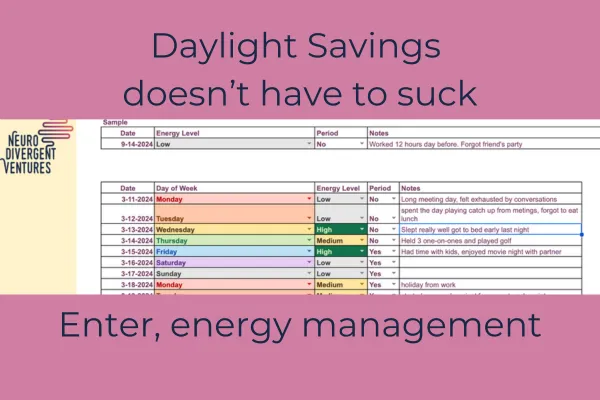Read My Latest Blogs
ADHD News, Trends, Goal-Setting Tips, and more!

How to acclimate to Daylight Savings
Energy management is a secret weapon for productivity and high achievement. You don’t have to be diagnosed with ADHD to utilize these strategies.
I have a love/hate relationship with daylight savings.
Love: The fact that there is light into the evening!
Hate: My whole house (my, kiddo, the dogs) get all off of our sleep schedules. Sleep is so incredibly important and prioritized in this house.
As someone with lots of executive dysfunction and time blindness because of my ADHD, I realize that this change also significantly throws off my routines, habits, eating, and sleeping. Having all those things up in the air makes my energy fluctuate from high to extremely low.
How do I keep my needs top-of-mind?
Tracking my energy.
Daylight savings is the perfect time to reset. The first thing you can do is track your energy.
View of a simple tracker you can download here.

Why Track My Energy?
Tracking your energy gives you qualitative and quantitative data to understand when and how your energy ebbs and flows. Once you have about 14-28 days, you will start to see patterns emerge.
Example:
You are always ‘LOW’ energy on Thursdays. Then you see that Wednesdays are long days (7:30am-9:30pm!) due to a longer work day then an extracurricular activity.
Once you have that information, you can ask yourself:
How can I support myself on Wednesday or Thursday? Perhaps if Wednesday’s schedule isn’t flexible, maybe Thursdays call for being a little more mellow and lower energy work?
From the qualitative side, you have a notes space on the energy tracker, this is a place where you insert some high-level details about your day. This can show you that there might be activities or even people who drain or elevate your energy. This is important to know.
Daylight savings can throw all these patterns into a tailspin, so tracking now can give you peace of mind as to why you are feeling ‘off’. You don’t have to white knuckle your way through. Give yourself some tracking time, log daily (progress not perfection), and check in with yourself!
Where to start
Tracking your energy can be as simple or as complicated as you want it to be. I created the Mood and Energy Tracker to be simple and streamlined to start.
Steps for tracking your energy with the Mood and Energy Tracker:
Download the Mood and Energy Tracker (it’ll be emailed to you)
Create a copy of the Google Sheet
Add your name to the top left
Daily- at roughly the same time every day, insert:
Date
Day of Week (dropdown)
Energy Level (dropdown)
If you are on your period (dropdown)
Note: I do not have menstrual cycle, and if you do, I recommend using this to understand how hormones impact your energy levels as well)
Notes: insert high-level info about the day. This could mean ‘all day staff meetings’ or even work was boring, and took a nap when I got home. These don’t need to be a novella.
Repeat for 28-45 days (progress not perfection, we are looking for data so it’s ok if you miss a day, just jump back in!)
Review results, see what patterns can be seen from the information you inserted
Energy management is a secret weapon for productivity and high achievement. You don’t have to be diagnosed with ADHD to utilize these strategies.

Hello! We use cookies, including third-party cookies, on this website to help operate our site and for analytics and advertising purposes.
©COPYRIGHT 2025 • NEURODIVERGENT VENTURES, LLC • ALL RIGHTS RESERVED
